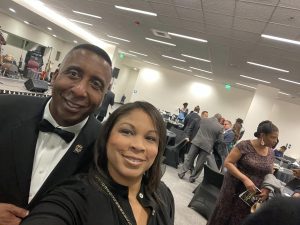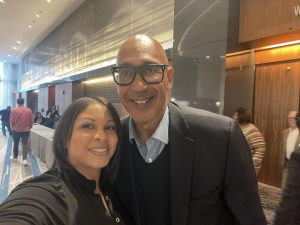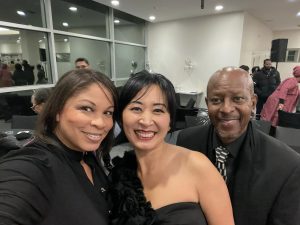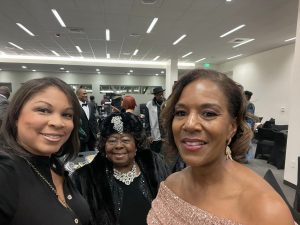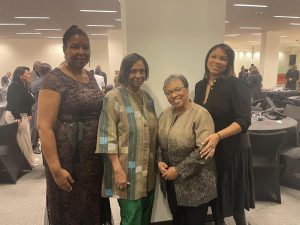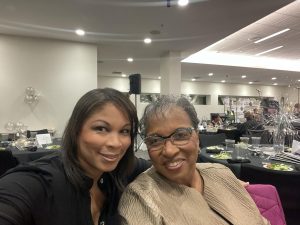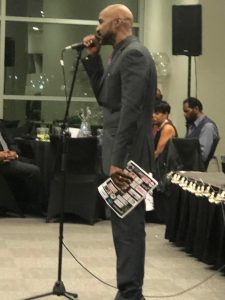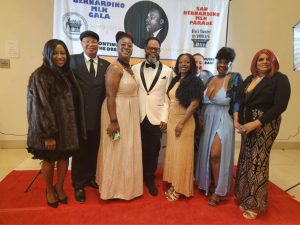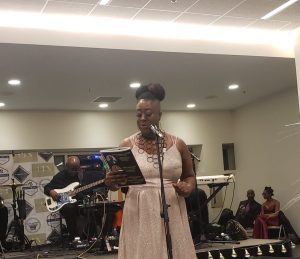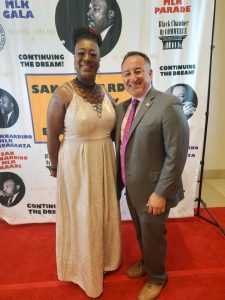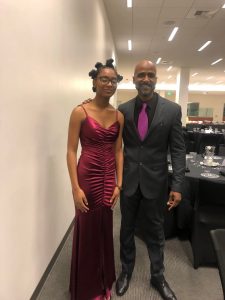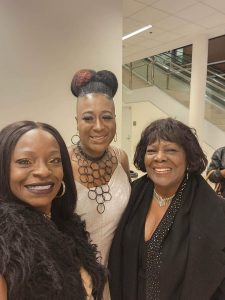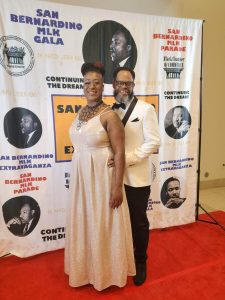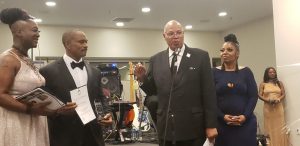SAN BERNARDINO, CA—- On Saturday, January 14, 2023, the Southern Black Chamber of Commerce held its annual Martin Luther King, Jr. Gala Service Awards. Honorees included dignitaries from around the Inland Empire which included Wallace Allen, Wilmer Amina Carter, Danny Tillman, Hardy and Cheryl Brown, Jimmy Jews, Damon & Felicia Alexander, and Darren Goodman. The evening was filled with a cocktail hour, live entertainment, dinner, and awards and recognitions that was held at the San Bernardino International Airport.
Apple Valley native relays a message during a general quarters drill aboard USS Nimitz
PHILIPPINE SEA—U.S. Navy Aviation Support Equipment Technician 1st Class Daniel Lopez Montoya, from Apple Valley, Calif., relays a message during a general quarters drill on the aircraft carrier USS Nimitz (CVN 68). Nimitz is in 7th Fleet conducting routine operations. 7th Fleet is the U.S. Navy’s largest forward-deployed numbered fleet, and routinely interacts and operates with 35 maritime nations in preserving a free and open Indo-Pacific region.
Adelanto native serves aboard USS Nimitz
PHILIPPINE SEA—U.S. Navy Aviation Structural Mechanic 3rd Class Jose Flores, from Adelanto, Calif., performs maintenance on a refueling system in the hangar bay of the aircraft carrier USS Nimitz (CVN 68). Nimitz is in 7th Fleet conducting routine operations. 7th Fleet is the U.S. Navy’s largest forward-deployed numbered fleet, and routinely interacts and operates with 35 maritime nations in preserving a free and open Indo-Pacific Region.
Community Action Partnership of San Bernardino County (CAPSBC) Receives $20,000 Grant from Stater Bros. Charities
SAN BERNARDINO, CA— Community Action Partnership of San Bernardino County (CAPSBC) was awarded a $20,000 grant by Stater Bros. Charities to support one of its newest programs, a Mobile Community Kitchen.
Stater Bros. Charities is at the forefront of helping to address food insecurity in San Bernardino County. The mobile program will roll out in 2023 as an expansion of CAPSBC’s other mobile services such as the Mobile Shower, Mobile Laundry, Mobile Offices and Mobile Food Pantry. These services are targeted for remote areas of the county to meet the needs of the most vulnerable residents. The Mobile Community Kitchen will provide nutritious hot meals to food insecure communities. CAPSBC’s goal is to increase the accessibility of healthy hot meal options to food deserts and underserved communities comprised of elderly, disabled, and homeless individuals.
“We are honored to be a recipient of these funds. Stater Bros. Charities and Stater Bros. Markets have consistently and generously supported our organization with both monetary and food donations,” said Patricia Nickols-Butler, CAPSBC President & Chief Executive Officer. “Partnerships like this help create a lasting impact in our communities. Last year alone, 214,415 individuals had access to nutritious hot meals prepared by our 27 partner soup kitchens and over 16 million pounds of food. Our new Mobile Community Kitchen will help increase the number of hot meals and will help us reach communities in the most remote areas of the county.”
“Stater Bros. Charities appreciates all that CAPSBC does not only to feed those in need but just as importantly, to feed their souls,” said Director of Stater Bros. Charities Danielle Oehlman. “In addition to food, CAPSBC’s mobile services such as Mobile Shower, Mobile Laundry, and Mobile Offices perform the important role of helping every person maintain their dignity.”
Stater Bros. Charities and Stater Bros. Markets are valued partners in the agency’s work to relieve hunger in local communities and CAPSBC is grateful to receive their support for the newest mobile service program.
About Community Action Partnership of San Bernardino County
Community Action Partnership of San Bernardino is the designated Community Action Agency for San Bernardino County and is charged with providing programs and services for over 800,000 low-income individuals and families to help lift them out of poverty. CAPSBC has been serving San Bernardino County since 1965. CAPSBC provides resources and opportunities to low-income residents to improve their lives, contribute to their communities, and offer a return on investment for our county. Core programs include Family Development, Energy, Education and Environmental Services and the Food Bank.
For more information, please call 909-723-1500 or e-mail info@capsbc.org or visit our website www.capsbc.org.
About Stater Bros. Markets
Communities throughout Southern California look to Stater Bros. Markets for Fresh. Affordable. Community First. grocery shopping every day. Stater Bros. nurtures families and their communities at more than 170 stores and through the helping hands of 18,000 caring employees. While the Stater Bros. meat counter is legendary for its quality and variety, every store department is designed to surprise and delight today’s shoppers. The company lives out its values through the charitable efforts of its non-profit, Stater Bros. Charities. Learn more at staterbros.com.
California Black Owned Businesses Set to Access More State Gov’t Contracts
By Jaivon Grant | California Black Media
Black and other minority-owned small businesses in California have actively fought for decades for more inclusion in California state government contracting opportunities.
Their hard work and patience paid off in September last year, when Gov. Gavin Newsom signed Assembly Bill (AB) 2019 into law.
Authored by Assemblymember Cottie Petrie-Norris (D-Irvine), the law took effect on Jan. 1. It mandates that state departments and agencies commit to providing at least 25% of all procurement opportunities to small businesses. Additionally, the bill requires state departments and agencies ensure that minority-owned and women-owned businesses are included in the procurement process, when contracting opportunities are available.
“California has invested billions of dollars to help small businesses and entrepreneurs achieve their California Dream,” said Newsom when signing the bill September 2022. “These new laws build on our efforts to create a more inclusive economy with renewed opportunity for innovation and growth for the country’s largest small business community. I’m thankful for the Legislature’s leadership and support to help the backbone of our economy thrive.”
Newsom signed AB 2019 after it passed in the Assembly unanimously with a 74-0 vote and it passed in the Senate 34-0.
Small businesses employ nearly 7.2 million workers (or 48.8% of all employees in California).
According to AB 2019, more than 39% of California’s 4.1 million small businesses (1.6 million) are minority owned. The bill is projected to have a significant positive impact on the overall economic stability of the state by enhancing state agencies’ ability to support underserved businesses in state contracting and encouraging entrepreneurship.
“Billions of dollars are at stake in our state contracting process and when we make it fair for diverse entrepreneurs, the success of these small businessowners lift up communities all across our state,” said Petrie-Norris, who is Chair of the Assembly Select Committee on Small Business and Entrepreneurship. “This bill will not only keep the state accountable, but it would give businesses that face systemic barriers an opportunity to succeed, keep families fed, create jobs and vitalize their communities.”
A coalition of minority-owned business advocacy organizations recently produced and released a video emphasizing some of the benefits of working with the state government.
“There are a lot of times where you’re questioning ‘am I going to have enough work for my small company,’” minority business owner Gary Efhan, CEO of Qualis Telecom stated in the video. “Without support, it’s pretty hard, and I’ve seen a lot of people go out of business.”
“Supporting us — and being in our communities –that will make a huge difference for sure,” Efhan added.
In the same video, CalAsian Chamber of Commerce President Pat Fong expressed that are many barriers to full participation for small businesses in California.
“Part of our goal with AB 2019 is to come up with an infrastructure that makes sense for small businesses,” Fong said. “There’s an understanding about what types of opportunities are available that are easy to access. How do we better connect California’s diverse businesses to those opportunities? I think that’s the challenge but also the opportunity.”
The California Hispanic Chambers of Commerce represents more than 815,000 Latino-owned business in California — organizations that, in aggregate, contribute more than 7% to the United States’ GDP, the organization says.
“As proud co-sponsors of AB 2019, we are thankful that the bill is now signed by the Governor,” said Julian Canete, President of the California Hispanic Chambers of Commerce. “There are numerous and diverse small businesses who can provide services and products to the State and this bill ensures they at least have a fighting chance to be awarded a contract. Thank you to Assemblymember Petrie-Norris for her work on this bill.”
The bill has garnered strong support from the California Chamber of Commerce, Small Business Majority, the California African American Chamber of Commerce, the California State Controller, California Hispanic Chamber of Commerce, California Asian Pacific Chamber of Commerce, and the National Association of Women Business Owners.
This California Black Media report was supported in whole or in part by funding provided by the State of California, administered by the California State Library.
KOTS (King of the Streets) MMA Underground Heavyweight Champion Stops by Empire Talks Back
REDLANDS, CA—- The theme of Wallace’s monologue is, “Become an anti-bigot!”. On Empire Talks Back show this past Sunday, January 8, Eugene Weems, KOTS (King of the Streets) MMA Underground Heavyweight Champion stopped by, along with Lue Dowdy and Deeveatva Bourne, who are the MLK Parade Coordinators and Parade Marshall. Baby “D” of J.J. Fad, the legendary Female Rappers from Rialto who performed the world-famous Gold Record, ‘Supersonic’ also stopped by the radio station.
Remembering Deborah Smith-Gilbert
EMPIRE NEWS NETWORK (ENN)—- The Westside Story Newspaper is sad to announce that on Monday, January 9, 2023, the Deborah Smith-Gilbert passed away. She was a member of the Inland Empire National Council of Negro Women (IENCNW). More information will be fore coming.
Beautillion Participants Learn About 35th Annual Oratorical Program
SAN BERNARDINO, CA— On Sunday, January 8, 2023, at the Community Youth Center in San Bernardino at the Social Lites, Inc. Beautillion meeting, former Sir Knight of Beautillion, Dr. Charles Brown of Alpha Phi Alpha Fraternity. Inc., Mu Xi Lambda Chapter along with member Dar’rell Jones and Twillea Evans-Carthen of Alpha Kappa Alpha Sorority, Inc., Eta Nu Omega Chapter, and member of Social Lites, Inc. presented information on the upcoming 35th Annual Oratorical Contest to participants of the Social Lites, Inc. Beautillion Program.
The Beautillion Program, now in its 56th year, is designed to help young men who are seniors in high school prepare for college through the solicitation of ads, leadership development, accountability, responsibility, etiquette, attire for all occasions, spiritual growth, public speaking, and community service. At the conclusion of the program one young man will be recognized “Sir Knight.”
The Beautillion program will conclude on April 1, 2023, at California State University, San Bernardino. For additional information, please contact Sheri Lewis (909) 320 – 0799, Elsie Paulino (951) 205-8823, or Marlene Davis (909) 709-5502.
Dr. King Annual Gala to Honor Award Recipients on Saturday, January 14
“This is a diverse event that honors Black, Latino, Asian, white and all ethnicities,” said LuCretia Dowdy, president of LUE productions, the event’s organizer. “All races and creeds are welcome to this celebration of unity.”
SAN BERNARDINO, CA—- On Saturday, January 14 from 5 p.m. to 9 p.m., the annual Dr. Martin Luther King Jr. Gala Awards is hosting a Red-Carpet Event at the San Bernardino International Airport. This year’s honorees are Wallace Allen, Wilmer Amina Carter, Danny Tillman, Hardy and Cheryl Brown, Jimmy Jews, Damon and Felicia Alexander and Darren Goodman.
“We are so happy to be honoring this year’s awardees,” said LuCretia Dowdy, president of LUE productions, the event’s organizer. “These people all have demonstrated diligent service to the communities they serve, helping to fulfill Dr. Martin Luther King Jr.’s dream of equality for all.”
The black-tie event will open at 5 p.m. with a cocktail hour and live entertainment that will regale attendees during the dinner, followed by the awards presentation. The airport is located at 275 North Leland Way in San Bernardino.
Damon Alexander serves on the San Bernardino City Council, representing the 7th Ward since November 2020. He has also been the Chairman of the City of San Bernardino’s Public Safety and Human Relations Commission, the Citizens Advisory Committee on Marijuana, as well as the President of the North End Neighborhood Association (NENA). His wife, Felicia, serves as Member at Large on the San Bernardino County Human Resources Equal Opportunity Commission.
Wallace Allen hosts a radio talk interview show, Empire Talks Back, on NBC affiliate KCAA and is the publisher of the West Side Story online newspaper that covers news and events happening in the west end of San Bernardino County.
Cheryl Brown is also a former California Assemblymember and current San Bernardino City Library Foundation Board member and Founder of the Black Voice News and the Black Voice Foundation. Hardy Brown College Prep, a tuition-free public charter K-12 school in San Bernardino, is named after her husband Hardy.
Wilmer Amina Carter served as California Assemblymember for the 62nd District and today is Director of Rialto-based Creative Business Services, Inc., She was the first Black elected to the Rialto Unified School District and served as district Director for the late Congressman George Brown for 21 years. Carter is the only living African American woman to have had a high school named after her, in her hometown of Rialto, Wilmer Amina Carter High School.
Danny Tillman is an information systems administrator for the County of San Bernardino Human Services Dept. and sits on the San Bernardino City Unified School District Board of Education, where he serves as the longest serving member and Board Vice President. He advocates for the success of district students.
The last two honorees both broke color barriers by becoming the first Blacks to be hired by their respective agencies. On June 16, 2022, Darren Goodman became the first Black chief of police in San Bernardino. He also served as the City of Upland’s first Black chief of police. His 31 years of law enforcement experience included 27 with the San Bernardino Sheriff’s Dept.
Jimmy Jews broke the color barrier as San Bernardino’s first Black firefighter in 1971 and retired 25 years later, having risen through the ranks to hold the positions of fire investigator and then as spokesperson, achieving the rank of Captain in 1989. Jimmy passed away on November 17, 2022, at the age of 79. He will be honored posthumously.
Event sponsors include the Southern California Black Chamber of Commerce and Youthbuild Inland Empire Charter School.
“This is a diverse event that celebrates Black, Latino, Asian, white and all ethnicities,” said Ms. Dowdy, “All races and creeds are welcome to this celebration of unity.”
For tickets and to RSVP for the event, call 888-466-7408 or go to the Black Chamber of Commerce website, info@blackchamberofcommerce.org.
Letter to the Editor: Inglewood Calls on Its Legislators to Help Return local Control to City’s Schools
By Joe W. Bowers Jr. | California Black Media
The Los Angeles County Office of Education (LACOE) will soon announce its choice for the next County Administrator for the Inglewood Unified School District (IUSD).
In the job description applicants were told “the district has made significant strides toward recovery and is within 3-4 years of being able to meet the minimum milestone for self-governance, offering the successful candidate a rare leadership opportunity.”
If history is any indication, IUSD has had eight State/County Administrators (including 3 interim) in a little over 10 years. The odds are against the ninth administrator being around to coordinate IUSD’s transition back to local control.
The IUSD Board of Education should be selecting the next leader for the school district, not LACOE. But, in 2012 facing the possibility of insolvency, Senate Bill 533 authorized a state loan and gave the State Superintendent of Public Instruction (SPI), Tom Torlakson control over IUSD. In 2018, Assembly Bill 1840 transferred authority to LACOE Superintendent Debra Duardo.
Since 2012, IUSD’s five-member Board of Education has been serving in an advisory role to the revolving door of appointed State and County Administrators.
Existing laws governing receivership say that a school district will regain control when it shows adequate progress in implementing the recommendations of a comprehensive review conducted by the Fiscal Crisis and Management Assistance (FCMAT) in five operational areas (financial management, personnel management, community relations and governance, facilities management, and pupil achievement).
FCMAT is an independent and external state agency that provides financial management assistance and general consulting to the state’s school districts. Their latest review of IUSD generated 885 recommendations for implementing 153 operational standards spread across the five operational areas.
IUSD has achieved proficiency in just two of the FCMAT operational areas – governance and personnel management – after 10 years under State and County control.
Existing laws give Duardo, with the concurrence of SPI Tony Thurmond and State Board of Education President Linda Darling-Hammond, the power to determine when IUSD can resume local control. However, many Inglewood residents familiar with the school district believe it’s Duardo’s choice of administrators that are failing to conform with FCMAT standards.
The nine reviews FCMAT conducted show that constant turnover of leadership and the number of poor leader choices by the State and County have led to inconsistency in developing and executing effective recovery plans for IUSD, stunted academic progress for the students, and inadequate maintenance of IUSD facilities.
When Torlakson took over IUSD, he said, “The State Administrator will control the district until fiscal insolvency has been eliminated, between two to six years.
The commentary I wrote titled, “After 10 Years it’s Time to Return Control of Inglewood Schools to the Community,” showed that ten years of state intervention is not a guarantee that a school district in receivership will be better managed.
While existing law mandates that the state controls IUSD to protect its $29 million loan, the opportunity cost to IUSD of the state’s mismanagement has been significantly more than the amount it borrowed.
For example, before receivership, the Los Angeles World Airports (“LAWA”) agreed to fund noise mitigation measures for IUSD not to exceed $118.5 million. The State/County Administrators who took over have only secured $44 million of the funding, leaving $74.5 million on the table.
City Honors High School is a dependent charter school run by IUSD that was recognized by U.S. World and News Report as a silver-medal finalist. When the Charter Schools Facilities Program was awarding grants for charter school construction, Don Brann, who Torlakson had appointed to oversee IUSD, didn’t apply for a state grant. But, DaVinci Charter schools which Brann helped found in the Wiseburn Unified School District located next door to IUSD applied and was awarded a $52.7 Million grant. Had IUSD applied for a grant for a City Honors building it would have been ahead of DaVinci in line for the limited funds.
Since 2012, IUSD has paid FCMAT about $2.6 Million for the nine yearly comprehensive reviews, an expense mandated by the statue authorizing the loan and paid from the school district’s General Fund.
IUSD is no longer in financial trouble. According to the latest 2022-23 budget projections, it will have a positive ending General Fund balance of $94.5 million and positive ending cash balance of $83.7 million. IUSD owes $19.6 million on its state loan.
In a recent review FCMAT conducted, LACOE admitted that IUSD had made little annual progress and is no closer to recovery today than two years ago.
IUSD has gone without local control longer than any school district that’s taken a state loan. It can no longer afford the compromised quality of education being delivered to students by LACOE’s management.
The IUSD community has been expressing its frustration at school board meetings about the quality of the schools the last 10 years, but LACOE lacks the management judgment to effectively respond to community concerns.
Schools LACOE operates not including IUSD, lead all California with the largest gap between Black and White students meeting states standards on the 2022 Smarter Balanced Assessments in English language arts.
Because statues governing state loans offer no way for IUSD to regain local control at this time, legislation amending those statues is needed that recognizes for 10 years State and County administrators have failed IUSD students and that it’s in the best interest of IUSD students to have the school board retain all of its legal rights, duties and powers.
The education system in California is based on local control
The new legislation needs to recognize that a statute of limitations has to be established on how long school districts under receivership have to put up with ineffective state management, especially if the school district is no longer in financial hardship.
Specific agencies have to be identified in the legislation with authority to hold the State or County accountable for addressing the slow progress it is making to qualify the district for a return to local governance. Incentives for quick turnarounds must be offered.
The offices of the legislators representing IUSD – Sen. Steve Bradford (D-District 35) and Assemblymembers Tina McKinnor (D-District 61) and Isaac Bryan (D-District 55) have been approached about the need for legislation to return local control to IUSD. The office of recently elected Sen. Lola Smallwood-Cuevas (D-District 28) was also contacted, but no staff was available to discuss legislation.
Support from the California Legislative Black Caucus is also being solicited.
It will be up to IUSD’s legislators to introduce a bill during this legislative session for the return of IUSD to local control.
 Westside Story Newspaper – Online The News of The Empire – Sharing the Quest for Excellence
Westside Story Newspaper – Online The News of The Empire – Sharing the Quest for Excellence
